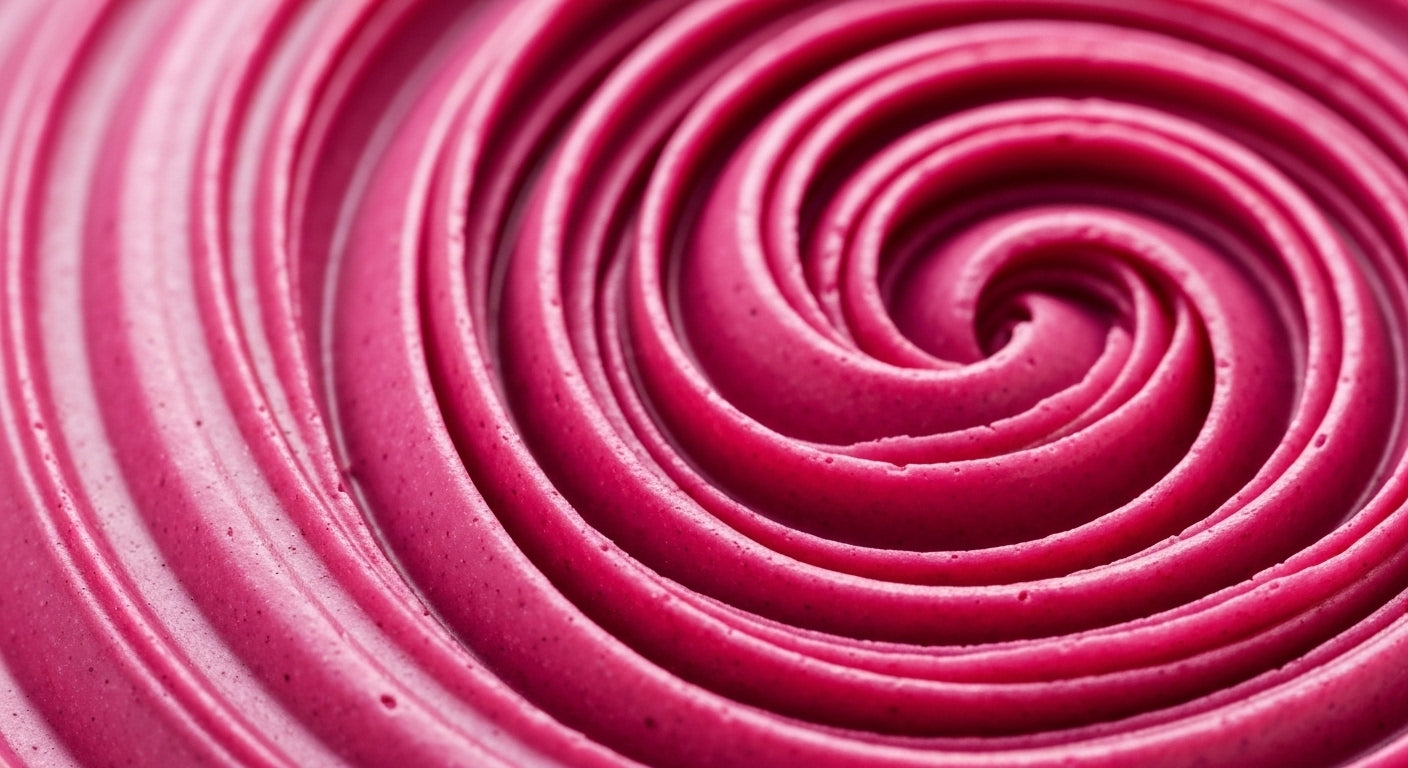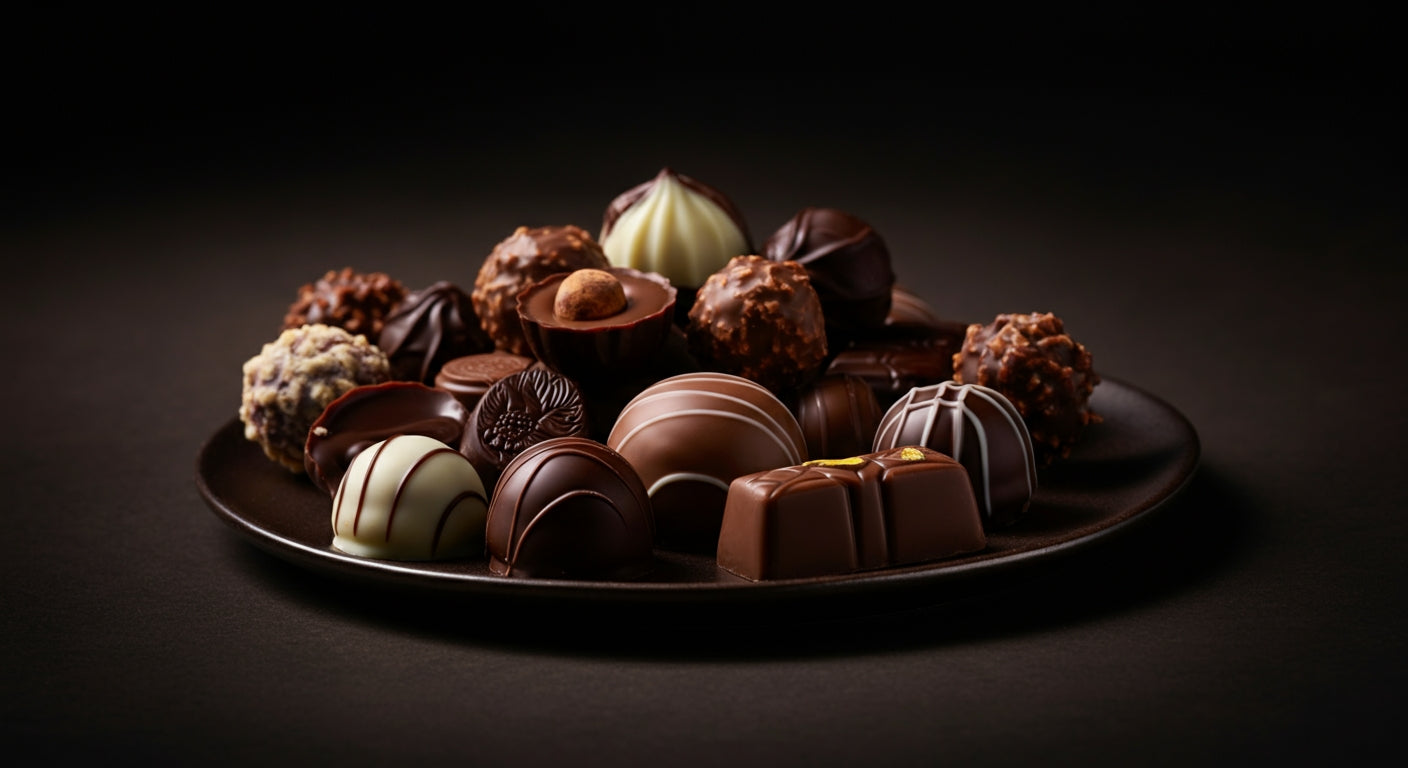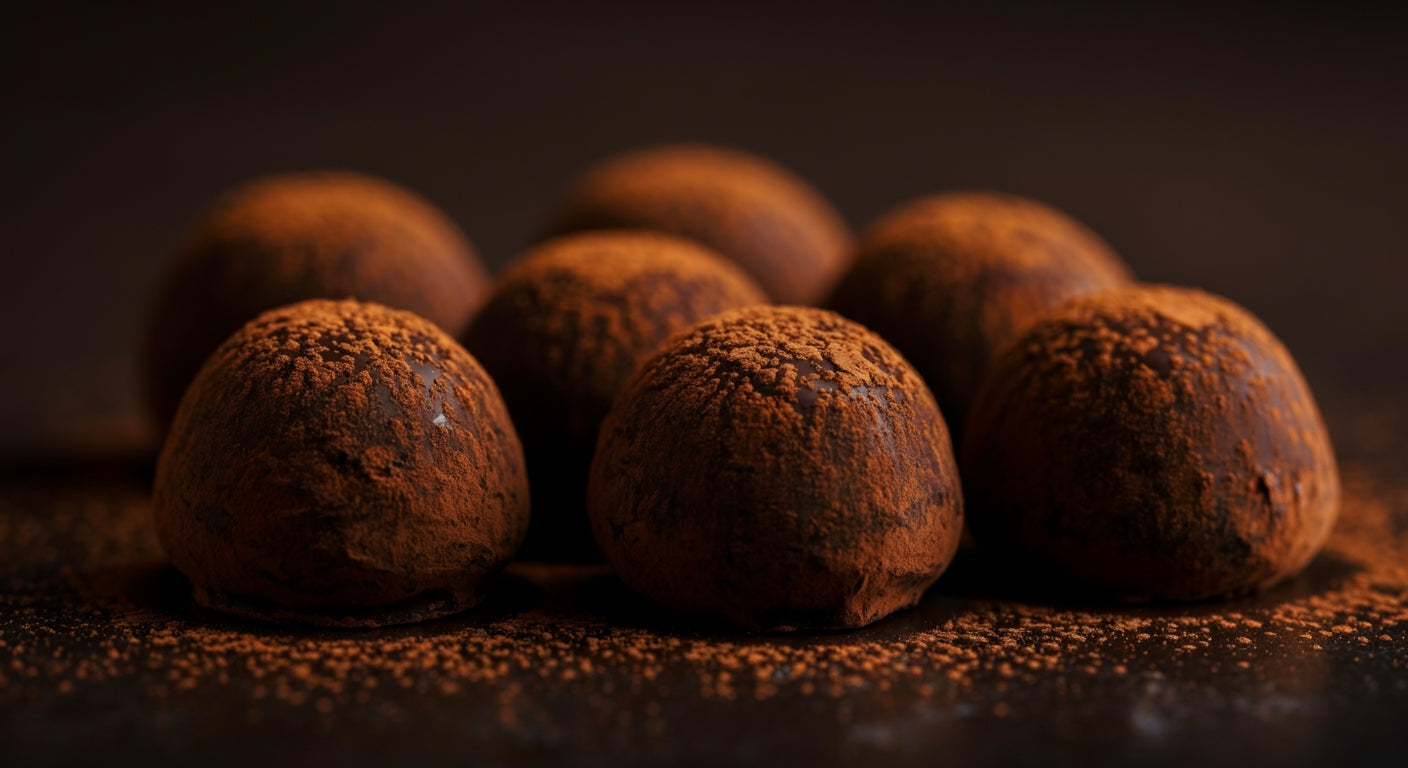
Ruby Chocolate: The Complete Guide to the Fourth Type of Chocolate
Ruby chocolate burst onto the chocolate scene in 2017 as the first new natural chocolate variety discovered in over 80 years, captivating chocolate lovers worldwide with its stunning natural pink color and unique berry-like flavor. But what exactly is ruby chocolate? How is it made? And most importantly, where can you find quality chocolate with similar fruity, innovative flavors? This comprehensive guide explores everything you need to know about ruby chocolate—from its fascinating origin story to how it compares with other chocolate varieties, plus alternatives that offer similar taste experiences while aligning with conscious chocolate consumption.
Whether you're a chocolate enthusiast curious about the latest innovations or someone seeking chocolate with natural fruit flavors, understanding ruby chocolate helps you appreciate the diverse world of premium chocolate craftsmanship.
Quick Answer for Voice Search: Ruby chocolate is the fourth type of chocolate, introduced in 2017 by Barry Callebaut. Made from ruby cocoa beans through a unique processing method, it has a natural pink color and tangy berry-like flavor reminiscent of raspberries and strawberries, containing no added colors or fruit flavorings. It sits between white and milk chocolate in sweetness, offering approximately 47.3% cocoa content.
What Is Ruby Chocolate?
The Fourth Type of Chocolate
For over 80 years, the chocolate world recognized only three main types: dark, milk, and white chocolate. Then ruby chocolate emerged as a genuine fourth category—not a flavored chocolate or colored coating, but an entirely distinct chocolate type with its own unique characteristics. Learn more about different types of chocolate and their classifications.
Ruby chocolate's defining features include:
Natural Pink Color: The distinctive rosy hue comes from the ruby cocoa beans themselves through specific processing, requiring no artificial colors or dyes.
Berry-Like Flavor: Tangy, fruity notes reminiscent of berries—particularly raspberries, strawberries, and red fruits—create a taste profile unlike traditional chocolate varieties.
Smooth Texture: Similar to white and milk chocolate in mouthfeel, ruby chocolate melts smoothly with a creamy consistency.
Moderate Sweetness: Less sweet than white chocolate but sweeter than dark chocolate, offering balanced sweetness with natural acidity.
Cocoa Content: Contains approximately 47.3% cocoa-derived ingredients (primarily cocoa butter with some cocoa solids), milk powder, and sugar.
Understanding what chocolate is made of helps appreciate how ruby chocolate's unique composition creates its distinctive characteristics.
How Ruby Chocolate Was Discovered
The story behind ruby chocolate combines decades of research, serendipitous discovery, and technological innovation. Barry Callebaut, one of the world's largest chocolate manufacturers, spent over 10 years developing ruby chocolate before its official unveiling in Shanghai in September 2017.
The discovery process involved:
Bean Selection: Identifying specific cocoa bean varieties with natural precursors that could develop pink coloration and fruity flavors.
Processing Innovation: Developing proprietary processing methods that unlock and preserve the ruby characteristics naturally present in the beans.
Stability Research: Creating techniques that maintain the pink color and flavor profile throughout manufacturing and shelf life.
Global Testing: Conducting extensive consumer testing across multiple continents to gauge market acceptance.
While Barry Callebaut keeps specific processing details confidential (protecting their intellectual property), the process involves careful bean selection, specific fermentation protocols, and controlled processing conditions that highlight natural ruby attributes. Learn about traditional cocoa bean processing to understand how ruby chocolate's method differs.

Ruby Cocoa Beans: Where Do They Come From?
Geographic Origins
Ruby chocolate requires specific cocoa bean varieties grown in particular regions. Barry Callebaut sources ruby cocoa beans primarily from three locations:
Ecuador: The Amazon region produces cocoa with unique flavor precursors ideal for ruby chocolate development.
Ivory Coast: West African cocoa contributes specific characteristics that enhance ruby chocolate's profile.
Brazil: Brazilian cocoa adds complexity to the final ruby chocolate blend.
These origins align with regions known for producing fine flavor cocoa with distinctive characteristics beyond bulk commodity beans. The concept of terroir—how environmental factors affect crop qualities—applies strongly to ruby chocolate production. Explore where chocolate comes from to understand chocolate's global journey.
What Makes Ruby Cocoa Beans Special?
Not all cocoa beans can become ruby chocolate. Specific requirements include:
Natural Precursors: Ruby beans contain particular compounds that, when processed correctly, develop into the characteristic pink color and fruity flavors. These precursors exist naturally in the beans' genetics and development.
Flavor Profile: The beans possess inherent fruity and acidic notes that processing amplifies rather than suppresses.
Processing Response: Ruby beans respond specifically to the proprietary processing methods, developing desired characteristics that other beans cannot achieve through the same treatment.
The exact botanical classification remains proprietary, but ruby cocoa likely includes varieties from the Trinitario and Nacional families known for fine flavor characteristics.
How Ruby Chocolate Compares to Other Chocolate Types
Ruby vs. White Chocolate
Both ruby and white chocolate contain no cocoa solids (only cocoa butter), but differ significantly:
Color: White chocolate is pale ivory to yellow; ruby chocolate is naturally pink.
Flavor: White chocolate tastes creamy and vanilla-forward; ruby chocolate offers fruity, tangy berry notes.
Sweetness: White chocolate is sweeter; ruby chocolate has natural acidity that balances sweetness.
Processing: White chocolate uses standard cocoa butter; ruby chocolate requires specific bean processing.
Ruby vs. Milk Chocolate
Milk chocolate contains cocoa solids providing traditional chocolate flavor, while ruby chocolate's profile diverges:
Chocolate Flavor: Milk chocolate tastes distinctly like chocolate; ruby chocolate emphasizes fruity notes over chocolate taste.
Cocoa Content: Milk chocolate typically contains 25-40% cocoa content; ruby chocolate contains approximately 47% (primarily cocoa butter).
Dairy: Both contain milk powder, creating creamy texture.
Color: Milk chocolate is brown; ruby chocolate is pink.
Ruby vs. Dark Chocolate
Dark chocolate and ruby chocolate represent opposite ends of the flavor spectrum:
Bitterness: Dark chocolate emphasizes cacao's natural bitterness; ruby chocolate highlights fruity sweetness and acidity.
Cocoa Solids: Dark chocolate contains 50-90% cocoa solids; ruby chocolate contains minimal cocoa solids with focus on cocoa butter.
Health Benefits: Dark chocolate offers higher antioxidant content from cocoa solids; ruby chocolate provides fewer antioxidants but unique flavor experience.
Understanding these differences helps chocolate lovers appreciate how ruby chocolate fits into the broader chocolate landscape. Discover more about types of chocolate bars and their characteristics.

The Science Behind Ruby Chocolate's Pink Color
Natural Color Development
Ruby chocolate's pink color develops naturally without added coloring—but how? The science involves complex chemistry:
Anthocyanins and Polyphenols: Ruby cocoa beans contain specific compounds that, under controlled conditions, contribute to pink coloration. While not identical to anthocyanins found in berries, similar mechanisms may be involved.
Processing Conditions: The proprietary processing method prevents oxidation and browning that typically occur during chocolate manufacturing, preserving lighter, pinker hues.
pH Levels: Carefully controlled acidity during processing influences final color, as many natural pigments are pH-sensitive.
Temperature Control: Specific temperature profiles during processing preserve color precursors while developing desired flavor characteristics.
Barry Callebaut emphasizes that no artificial colors, fruit flavors, or berry extracts are added—the pink color and fruity taste come entirely from the beans and processing method.
Why Ruby Chocolate Isn't More Common
Despite its novelty, ruby chocolate remains relatively rare in the market for several reasons:
Proprietary Process: Barry Callebaut controls the processing technology through patents, limiting who can produce authentic ruby chocolate.
Bean Sourcing: Only specific cocoa bean varieties work for ruby chocolate production, limiting supply.
Higher Costs: Specialized processing and limited bean sources increase production costs compared to conventional chocolate.
Market Education: Consumer understanding of ruby chocolate remains limited, requiring marketing investment.
Tempering Challenges: Ruby chocolate requires careful tempering similar to other chocolates but with specific temperature considerations to maintain color and texture.
Ruby Chocolate's Taste Profile and Culinary Uses
What Does Ruby Chocolate Taste Like?
Describing ruby chocolate's flavor challenges even experienced chocolate tasters because it differs so dramatically from conventional chocolate:
Initial Taste: Tangy and fruity with berry-forward notes—think raspberry, strawberry, and red currants.
Sweetness Level: Moderately sweet, less so than white chocolate but more than dark chocolate.
Acidity: Natural acidic notes provide brightness and balance, similar to fruit-infused chocolates.
Chocolate Flavor: Minimal traditional chocolate taste; cocoa butter provides richness without strong chocolate flavor.
Finish: Clean, fruity aftertaste without bitterness.
Texture: Smooth and creamy, melting easily at body temperature.
Some describe ruby chocolate as tasting like "white chocolate meets berry yogurt" or "fruity milk chocolate without the chocolate flavor."
Culinary Applications
Ruby chocolate's unique characteristics open creative possibilities:
Confectionery Coating: Works beautifully for coating truffles, creating visually stunning pink chocolates.
Baking: Incorporates into cookies, brownies, and cakes for color and flavor novelty.
Ganache: Creates pink ganache for filling pastries, cakes, or making truffles.
Decorating: Provides striking visual contrast when used alongside dark, milk, or white chocolate.
Pairings: Complements ingredients like pistachios, rose, lemon, champagne, white chocolate, and cream cheese.
For home chocolate-making inspiration, explore techniques in our guide on how to melt chocolate in the microwave or learn about tempering chocolate for professional results.
Controversies and Criticisms of Ruby Chocolate
Industry Skepticism
Not everyone embraced ruby chocolate enthusiastically. Some criticism includes:
Processing Concerns: Questions about whether ruby chocolate results from natural bean characteristics or primarily from processing manipulation.
Flavor Authenticity: Skeptics suggest the berry flavor comes more from processing than from beans themselves.
Classification Debate: Some argue ruby chocolate is simply processed white chocolate rather than a genuinely new chocolate type.
Ingredient Questions: Initial ingredient lists showed citric acid, raising questions about whether acidity comes from beans or added ingredients.
Marketing vs. Innovation: Critics view ruby chocolate as marketing innovation rather than genuine chocolate discovery.
Comparing Ruby Chocolate to Flavored Chocolate
A key distinction: is ruby chocolate a new chocolate type or simply flavored chocolate? Arguments on both sides:
Supporting "New Type" Classification:
- Natural pink color without added dyes
- Flavor comes from bean processing, not added flavoring
- Unique composition distinct from dark, milk, and white chocolate
- Consistent characteristics across batches and applications
Supporting "Flavored Chocolate" Classification:
- Minimal cocoa solids content similar to white chocolate
- Processing may be more important than bean variety
- Flavor profile differs significantly from traditional chocolate taste
- Limited availability suggests specialty product rather than fundamental type
Regardless of classification, ruby chocolate represents genuine innovation in an industry where significant breakthroughs are rare.

Where to Find Ruby Chocolate Products
Commercial Ruby Chocolate Availability
Since its 2017 introduction, ruby chocolate has appeared in various products:
KitKat Ruby: In 2018, Nestlé launched pink KitKat bars using ruby chocolate in select markets including Japan, South Korea, and parts of Europe.
Premium Chocolate Bars: Specialty chocolate brands offer ruby chocolate bars, often combined with complementary ingredients like pistachios or freeze-dried raspberries.
Confections: High-end chocolatiers create ruby chocolate truffles, bonbons, and pralines for luxury markets.
Baking Chips: Ruby chocolate chips enable home bakers to experiment with the ingredient.
Seasonal Products: Ruby chocolate appears in Valentine's Day and Easter products capitalizing on its pink color.
Availability varies significantly by region, with stronger distribution in Asia and Europe than North America.
Price Considerations
Ruby chocolate typically costs 20-50% more than conventional chocolate due to:
- Specialized bean sourcing
- Proprietary processing requirements
- Limited production scale
- Novelty premium
- Market positioning as luxury product
Fruity Chocolate Alternatives: Natural Berry Flavors Without Ruby Chocolate
Why Consider Alternatives to Ruby Chocolate?
While ruby chocolate offers unique characteristics, several factors might lead chocolate lovers to seek alternatives:
Availability: Ruby chocolate remains difficult to find in many regions.
Ethical Sourcing: Limited transparency about farming practices and farmer compensation.
Organic Options: Ruby chocolate typically isn't available in certified organic versions.
Processing Concerns: Some consumers prefer minimally processed chocolate.
Allergen Considerations: Ruby chocolate contains dairy, excluding vegan and dairy-free consumers.
Price: Premium pricing may not fit all budgets.
Chocolate with Natural Berry Flavors
Fortunately, innovative chocolatiers create exceptional fruit-forward chocolates using natural ingredients:
Freeze-Dried Fruit Inclusions: Incorporating freeze-dried raspberries, strawberries, or other berries into chocolate creates intense fruit flavor without added sugars or artificial flavors.
Our Superberry Chocolate features an antioxidant-rich berry core surrounded by dark chocolate, delivering authentic acai, raspberry, and pomegranate flavors. This approach provides genuine fruit taste while maintaining chocolate's nutritional benefits.
Raspberry-Infused Ganache: Raspberry Fudge Truffles combine sweet raspberry-infused ganache with dried raspberry topping for a fruity twist that rivals ruby chocolate's berry notes.
Fruit and Dark Chocolate Pairings: Learn more about dark chocolate bars and truffles that incorporate real fruit ingredients for authentic flavor.
Natural Fruit Powders: Some chocolatiers incorporate fruit powders that provide color and flavor without artificial additives.
Benefits of Artisan Fruit-Flavored Chocolate
Choosing artisan chocolates with natural fruit inclusions offers several advantages:
Transparency: Clear ingredient lists showing real fruit ingredients.
Organic Options: Many artisan chocolates use certified organic ingredients.
Ethical Sourcing: Direct trade and fair trade relationships ensure farmer welfare.
Vegan Availability: Plant-based chocolates accommodate more dietary preferences.
Nutritional Value: Real fruit adds antioxidants, vitamins, and fiber.
Environmental Consciousness: Sustainable farming practices and climate-neutral production.
Explore our complete collection of vegan chocolate featuring innovative flavors that celebrate natural ingredients and conscious craftsmanship.
Storing and Working with Ruby Chocolate
Proper Storage Techniques
Ruby chocolate requires careful storage to maintain its unique characteristics:
Temperature: Store at 65-68°F (18-20°C) in a consistent environment. Temperature fluctuations can cause bloom.
Light Protection: Keep away from direct sunlight, which can fade the pink color over time.
Humidity Control: Maintain humidity below 50% to prevent sugar bloom.
Airtight Containers: Protect from odors and moisture with proper sealing.
Shelf Life: Properly stored ruby chocolate typically lasts 12-18 months, shorter than dark chocolate but comparable to milk and white chocolate.
Learn comprehensive chocolate preservation techniques in our guide on how long chocolate lasts.
Tempering Ruby Chocolate
Working with ruby chocolate requires understanding its specific tempering requirements:
Melting Temperature: Heat to 104-113°F (40-45°C), similar to white chocolate.
Cooling Temperature: Cool to 78-80°F (25-27°C).
Working Temperature: Reheat to 84-86°F (29-30°C) for optimal working consistency.
Tempering Challenges: Ruby chocolate is more temperamental than dark chocolate, requiring precise temperature control to maintain color and texture.
Color Preservation: Overheating can cause color darkening, so careful temperature monitoring is essential.
For detailed tempering instructions, review our comprehensive guide on how to temper chocolate like a pro.
The Future of Ruby Chocolate and Chocolate Innovation
Will Ruby Chocolate Become Mainstream?
Ruby chocolate's future trajectory remains uncertain. Several factors will influence its long-term success:
Market Acceptance: Consumer education and repeated exposure will determine whether ruby chocolate becomes a pantry staple or remains a novelty.
Price Reduction: Scaling production could reduce costs, making ruby chocolate more accessible.
Product Innovation: Creative applications beyond basic bars may expand appeal.
Competition: If patents expire or alternative production methods emerge, increased competition could drive adoption.
Sustainability Concerns: Growing consumer focus on ethical and environmental practices may impact ruby chocolate's positioning.
What Ruby Chocolate Teaches About Chocolate Innovation
Regardless of ruby chocolate's ultimate market position, its development illustrates important trends:
Processing Innovation: Advances in processing technology can reveal new possibilities from familiar ingredients.
Consumer Experience: Modern chocolate consumers seek novelty, visual appeal, and unique sensory experiences beyond traditional options.
Marketing Power: Effective storytelling can create excitement around new product categories.
Challenges of Innovation: Even significant innovations face skepticism, regulatory questions, and market barriers.
The history of chocolate shows that major innovations—from solid chocolate bars to conching machines to bean-to-bar movements—often face initial resistance before potential widespread adoption.
Frequently Asked Questions About Ruby Chocolate
Is ruby chocolate actually chocolate or just colored white chocolate?
Ruby chocolate is legitimate chocolate made from cocoa beans, containing approximately 47% cocoa-derived ingredients (primarily cocoa butter). While its composition resembles white chocolate (both lack cocoa solids), ruby chocolate's natural pink color and berry-like flavor come from specific bean varieties and proprietary processing methods, not added coloring or flavoring. Whether this constitutes a genuinely new chocolate "type" or an advanced processing technique applied to white chocolate remains debated, but ruby chocolate is unquestionably real chocolate rather than compound coating or candy.
Does ruby chocolate taste like raspberries or strawberries?
Ruby chocolate has a naturally fruity, berry-like flavor reminiscent of raspberries, strawberries, and red currants, but it doesn't taste exactly like any specific berry. The tangy, slightly acidic fruit notes come from the cocoa beans and processing method, not from added fruit flavoring. The taste is distinctly fruity but also maintains a creamy, chocolate-like quality from the cocoa butter. Most tasters describe it as a unique flavor experience that evokes berries without being overtly fruit-flavored, similar to how chocolate evokes earthiness and bitterness without being explicitly bitter.
Why is ruby chocolate pink without any added color?
The natural pink color develops through a proprietary processing method that Barry Callebaut developed specifically for ruby cocoa beans. While exact details remain trade secrets, the process preserves and enhances natural compounds within the beans that create pink pigmentation. This likely involves controlling oxidation, pH levels, temperature, and other processing variables that typically cause cocoa to brown during conventional chocolate production. No artificial colors, dyes, or fruit additions create the color—it comes entirely from the beans themselves when processed correctly.
Is ruby chocolate healthier than other chocolate types?
Ruby chocolate offers similar nutritional profiles to milk or white chocolate rather than dark chocolate. It contains cocoa butter (providing some beneficial fats), milk powder, and sugar, with minimal cocoa solids that provide antioxidants in dark chocolate. Ruby chocolate's caffeine content is very low, similar to white chocolate. While not particularly unhealthy, ruby chocolate doesn't offer the significant health benefits associated with high-cacao dark chocolate. For health-conscious chocolate lovers, dark chocolate with 70-85% cacao provides more antioxidants, minerals, and beneficial compounds.
Can I make ruby chocolate at home?
Unfortunately, no. Creating authentic ruby chocolate requires specific cocoa bean varieties and Barry Callebaut's proprietary processing technology protected by patents. Home chocolate makers cannot replicate ruby chocolate using standard cocoa beans or typical chocolate-making techniques. However, you can create visually similar pink chocolate using white chocolate with natural coloring (like beet powder or freeze-dried raspberry powder) and adding fruit flavorings. While not identical to ruby chocolate, this creates pink chocolate with berry flavors. Alternatively, explore artisan chocolates like our raspberry-infused truffles that deliver authentic fruit flavors through natural ingredients.
Featured Snippet Summary
What is ruby chocolate? Ruby chocolate is the fourth type of chocolate, introduced in 2017, made from ruby cocoa beans using a unique processing method. It has a natural pink color and fruity, berry-like flavor without added colors or fruit flavorings, containing approximately 47% cocoa content with a taste profile sitting between white and milk chocolate in sweetness.
Experience Exceptional Fruit-Forward Chocolate Today
Ruby chocolate represents an exciting chapter in chocolate innovation, proving that even after thousands of years of chocolate enjoyment, new discoveries remain possible. While authentic ruby chocolate offers unique characteristics, the chocolate world contains countless other innovations celebrating natural flavors, ethical production, and creative craftsmanship.
For chocolate lovers seeking berry-forward flavors, vibrant colors, and innovative taste experiences, exploring artisan chocolates with real fruit ingredients provides similar excitement while supporting transparent, sustainable practices. Rather than relying on proprietary processing, these chocolates showcase the natural synergy between chocolate and fruit through simple, honest ingredients.
Ready to explore chocolate that combines innovation with integrity? Discover our Superberry Chocolate—an antioxidant-rich blend of organic acai, raspberry, and pomegranate surrounded by premium dark chocolate. Experience authentic berry flavors that come from real fruit rather than processing manipulation, all while supporting regenerative farming and fair trade practices.
Our complete collection of vegan chocolate bars and truffles features innovative flavor combinations that push boundaries while respecting traditional chocolate-making values. From Raspberry Fudge Truffles to classic dark chocolate, every product combines organic ingredients, ethical sourcing, and artisan craftsmanship.
Whether you're intrigued by ruby chocolate's innovation or prefer time-tested approaches to chocolate-making, the modern chocolate landscape offers something for everyone. Shop our collection today and experience how conscious chocolate choices can deliver both extraordinary flavor and positive impact—one delicious bite at a time.

Claire Bennett
I'm Claire, a chocolate lover and artisan based in a small town where I run a tiny home kitchen dedicated to exploring everything chocolate. From single-origin dark bars to creamy ganache and handmade truffles, I find joy in working with all types of chocolate. I believe chocolate has a story, and I love bringing that story to life through humble, heartfelt creations.



Leave a comment
This site is protected by hCaptcha and the hCaptcha Privacy Policy and Terms of Service apply.